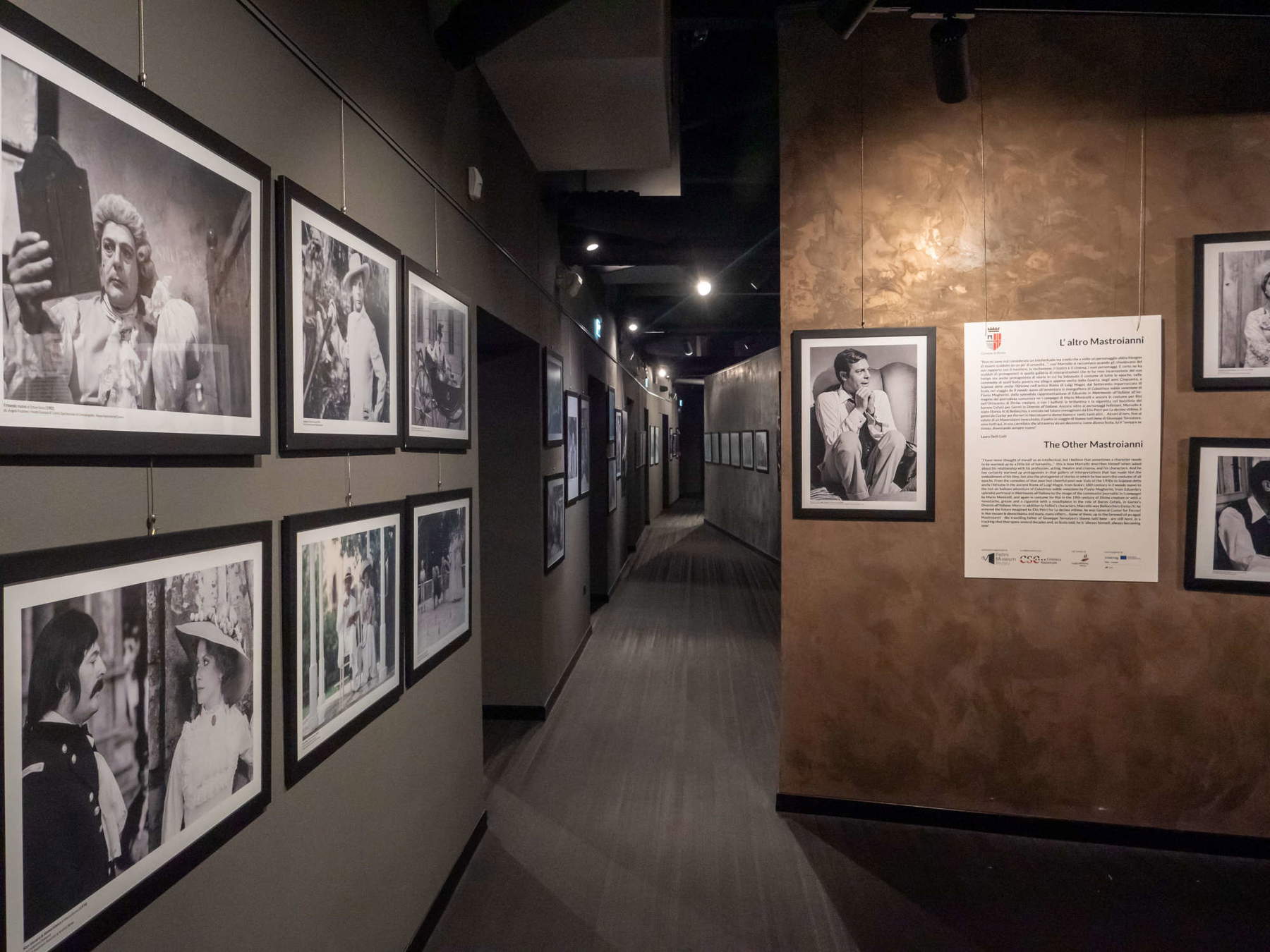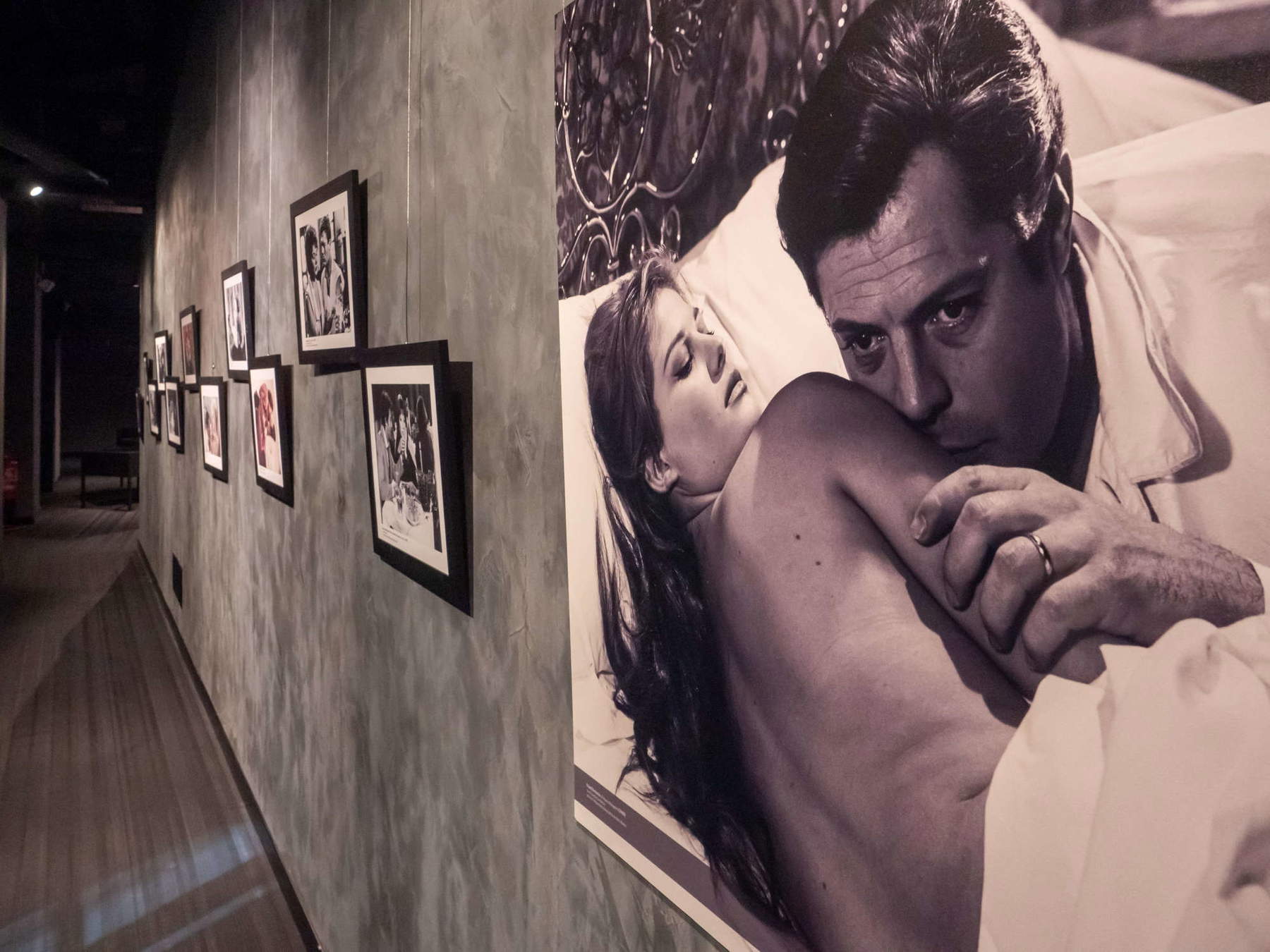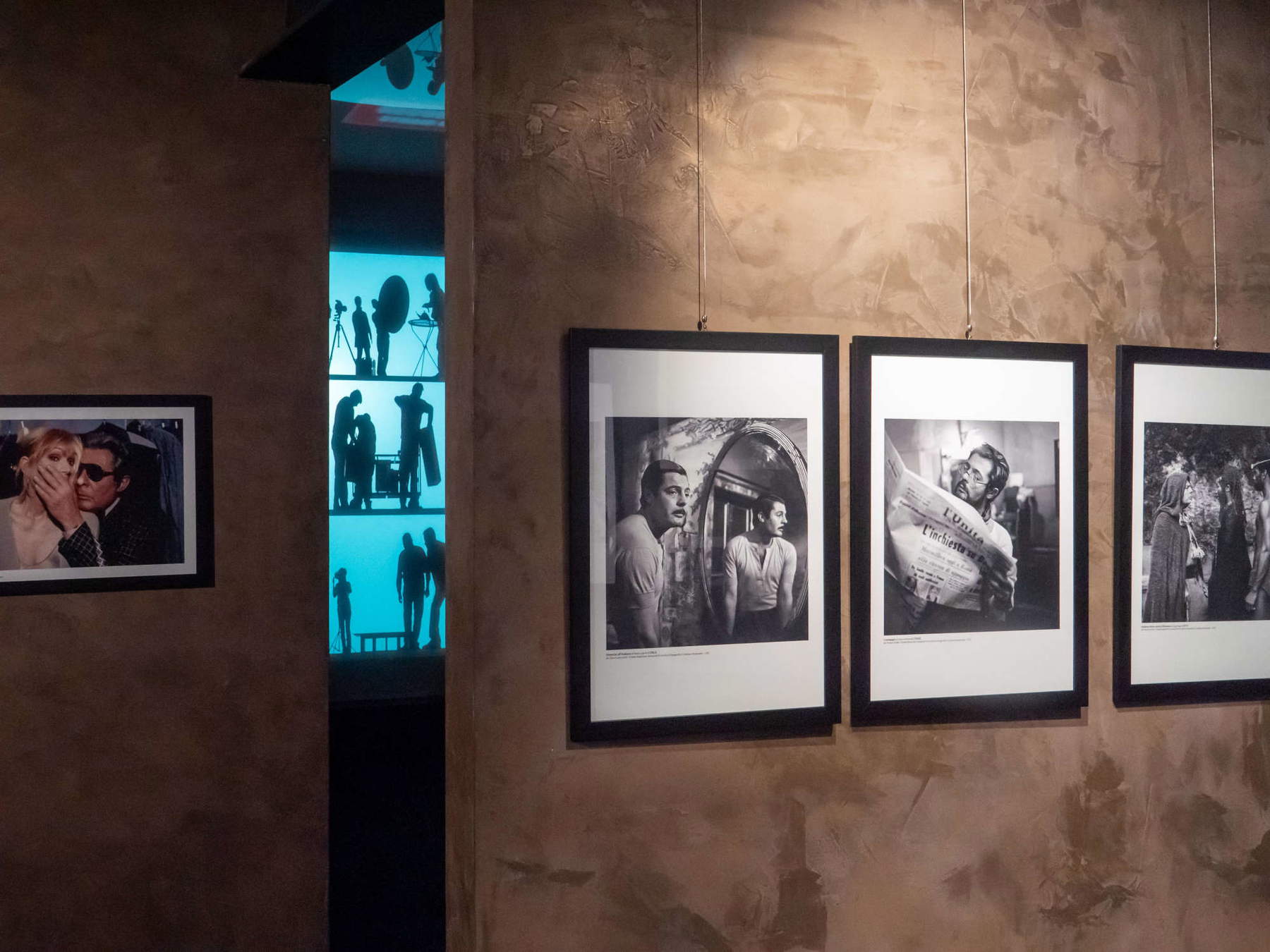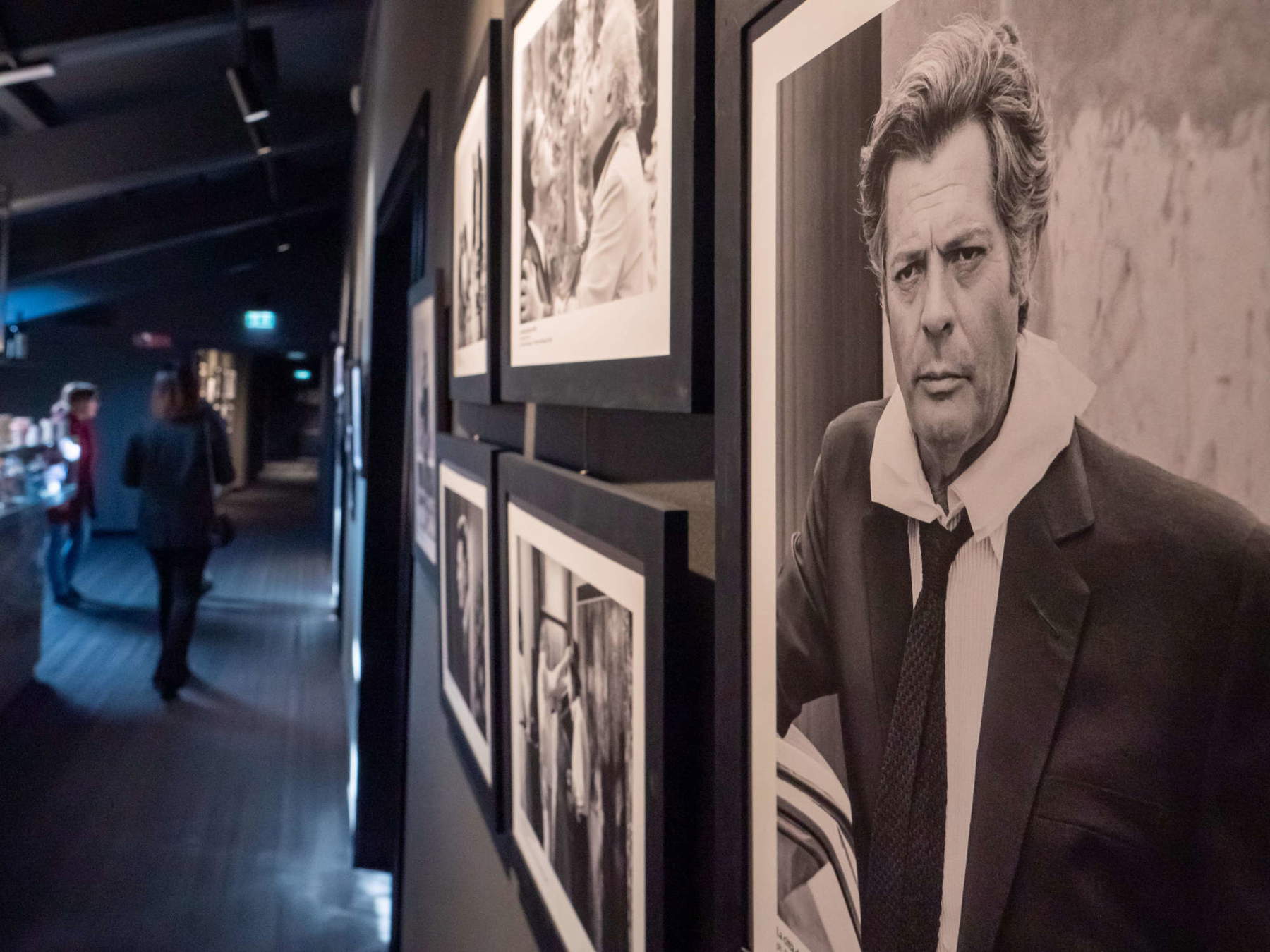Rimini lights up in remembrance of Marcello Mastroianni, the actor of undisputed charm who was able to conquer the world with his authenticity. On the day that coincides with the anniversary of the passing of his friend and mentor Federico Fellini, namely last Oct. 31, Rimini inaugurated the exhibition Simply Marcello. An Antidiva of Success at the Palazzo del Fulgor, paying homage to a timeless icon and star of Italian cinema. Curated by Laura Delli Colli, the exhibition celebrates 100 years since the birth of Mastroianni, who was born on Sept. 28, 1924, and will be on view until Jan. 20, the date of Fellini’s birth. Rimini, the city that Fellini made immortal, is dedicating a series of events to the special relationship between the director and the actor, celebrating both the friendship between the two and Mastroianni’s talent.
With more than 120 images, the exhibition Simply Marcello offers an intimate and public portrait of the actor. Each shot, from rare backstage moments to iconic scenes on set, tells a story. The itinerary opens with a never-before-seen photograph of Mastroianni on the beach in Rimini, during the historic EuropaCinema84 edition, immortalized by Flavio Marchetti’s lens. The exhibition is divided into five sections, each with a theme dedicated to a different side of the actor.


The first section, Marcello!, explores the glossy, international star image of the actor, whose face had become a symbol of Italian-ness. Between Piazza Duomo, the Monza circuit, and Venetian gondolas, Mastroianni poses for a series of shots that portray him as an icon, often wearing a star-like aura, though for him not without irony. This is followed by L’altro Marcello, where the actor’s more authentic side emerges: a simple man, never completely at ease in the “latin lover” role that cinema had sewn on him. Unseen shots show Mastroianni in breaks on the set, revealing his disarming smile and reserved character, far from glamorous poses.
Moving on, The third section, Marcello on Stage, collects iconic images from his films, offering an excursus of the actor’s film career. Among the most memorable sequences, images from La dolce vita and 8½, Fellini’s masterpieces that consecrated Mastroianni internationally, cannot be missed. The fourth section, Il dolce cinema, is dedicated to on-set romances with some of the greatest actresses of the time, from the unforgettable Anita Ekberg to the talented Claudia Cardinale. The images recount Mastroianni’s ability to play roles capable of enchanting audiences, so much so that he became an icon of seduction. Yet Marcello always refused the label of “latin lover,” preferring to remain an “antidiva,” far from the media persona that the magazines often attributed to him. The exhibition concludes with the section Caro Marcellino. .., a tribute to the relationship of esteem and friendship that bound Mastroianni to Fellini. The director saw in him not only a great actor, but an alter ego on the big screen, a figure capable of embodying Italian-ness in all its facets. For Fellini, Mastroianni was more than an actor; he was his inspiration, a confidant, a friend. And this section, with the most intimate and personal images, is a tribute to the human and friendly side that the two shared.


Marcello Mastroianni, an icon of Italian and international cinema, remains one of our country’s most fascinating 20th-century figures. Born in 1924 in a village in Ciociaria, Fontana Liri, and raised in Rome, Mastroianni represented a generation of actors who, between the 1950s and 1980s, redefined Italy’s image in the world. But his uniqueness lay not only in extraordinary talent or innate elegance; Marcello was an “antidiva” par excellence, a figure who eschewed clichés and, while willingly accepting notoriety, avoided the blinding lights of the star system.
Mastroianni’s career takes off in a difficult context. These are the years of World War II, and the young Marcello, after studying acting, turns to the theater. His stage presence and natural charm attract the attention of a number of directors, but it is the cinema that quickly brings him into the limelight. Thanks to increasingly significant roles, Marcello demonstrates a chameleonic talent, able to switch from drama to comedy with disarming naturalness. His consecration came with Federico Fellini’s film La dolce vita (1960), where he plays a disenchanted journalist who moves among the temptations of a decadent Rome. The scene in which he plunges into the Trevi Fountain with Anita Ekberg is now an immortal image of world cinematography.
The relationship between Mastroianni and Fellini left a deep mark on both of them. Fellini, considered one of the greatest directors in the history of cinema, found in Marcello a sort of alter ego, a performer capable of bringing his tormented and complex characters to life. The two collaborated again in 8½ (1963), one of Fellini’s absolute masterpieces. Here, Mastroianni plays Guido Anselmi, a director in creative crisis who reflects the same restlessness as Fellini and, in part, Mastroianni himself. In this role, the actor is not just a performer, but becomes the symbol of the modern man in perpetual conflict with himself. This artistic bond, based on esteem and friendship, created some of the most intense and memorable scenes in Italian cinema.
Unlike many stars of the time, Mastroianni never allowed himself to be carried away by the lure of Hollywood, even though he received numerous proposals. And when he found himself shooting with actresses such as Sophia Loren, Brigitte Bardot, and Catherine Deneuve, Mastroianni always maintained his authentic simplicity. He was often described as the Italian “latin lover,” a label he himself ironically rejected because he did not recognize himself in the role of the seducer.Mastroianni was a man who focused on the quality of work and the truth of acting.
This attitude was also reflected in his personal choices: despite his numerous relationships, Marcello was never part of scandals and gossip, always maintaining a reserved and discreet image. His relationship with Catherine Deneuve, from which his daughter Chiara was born, represents one of the rare cases in which his private life made it to the headlines. However, even in this situation, Mastroianni managed to maintain the grace and dignity that characterized him.
In the 1970s and 1980s, Mastroianni continued to play roles of great complexity. He worked with directors such as Ettore Scola, in films such as Una giornata particolare (1977), alongside Sophia Loren, where he played a character diametrically opposed to his usual role as lover and seducer: here he is a fragile, sensitive man living a marginal existence during the Fascist regime. Once again, Mastroianni demonstrates his ability to cast himself in different roles, confirming a versatility that distances him from the glossy stars.
Working with Scola represented a turning point for Mastroianni, as the director knew how to make the most of his dramatic abilities. Another significant example is Il mondo nuovo (1982), where Mastroianni plays King Louis XVI, offering an intimate and human portrait of a ruler on the verge of being swept away by History.
Marcello Mastroianni was nominated three times for an Oscar, a record for an Italian actor. Although he never received the statuette, his contribution to cinema was recognized and appreciated worldwide. In 1996, shortly before his death, the Venice Film Festival presented him with a Golden Lion for Lifetime Achievement, an award celebrating an extraordinary artistic career and absolute dedication to the craft of acting.
Mastroianni represented an Italy made of irony and melancholy, a country capable of laughing and crying together. His roles embodied a nostalgia for an era that was now disappearing, but at the same time reflected the change of an evolving Italy. He is credited with performances that explored the most complex sides of the human soul, from the existential dilemmas of a director in crisis to the dramas of the common man, passing through historical roles and surreal characters.
Marcello Mastroianni always stood out for his simplicity and modesty, qualities that made him beloved by audiences and respected by colleagues. Until the end of his life, he remained an actor “by trade,” faithful to his art without ever giving in to protagonism. When he passed away on Dec. 19, 1996, the film world lost not only a great actor, but also a man who had been able to maintain his authenticity in an often artifactual world. And even today, years after his passing, Mastroianni remains a symbol of the best of Italian cinema.
 |
| Rimini celebrates 100 years of Marcello Mastroianni with exhibition at Fulgor Cinema |
Warning: the translation into English of the original Italian article was created using automatic tools. We undertake to review all articles, but we do not guarantee the total absence of inaccuracies in the translation due to the program. You can find the original by clicking on the ITA button. If you find any mistake,please contact us.